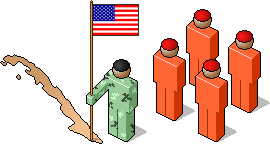
 Mapping provides a unique way to create new ways of imagining the world and perhaps new ways of living within it. Such is the power of one of the canonical representational practices.
These image is an example of mapping done by the design denizens of www.style.org. Here, the January 2005 Iraqi election (not the more recent referendum) is visually compelling for all the usual reasons, not the least of which is the ability to interactively create your own modified representation.
I’m particularly interested in the possibilities that web-based mapping (e.g. Google Mapping Mash-ups) tools and practices may lead to more self-visualizations. By that I mean representations of the world using one of the most iconic visualization practices — map making. This may be the legacy of Google Maps, if I can be so bold as to be optimistic for a moment. If the open Google Map API provides a straightforward way for networked publics to create new social formations through visual representations, that is a powerful new practice. Sure, things like HousingMaps.com are cool, but imagine if local communities were able to map landlord violations? And instead of FastFood maps (blech..), healthy living maps?
Many of the existing Google Maps mash-ups are so..borgeoise.
Google Maps Mania keeps an unofficial list of existing Google Maps mash-ups.
Mapping provides a unique way to create new ways of imagining the world and perhaps new ways of living within it. Such is the power of one of the canonical representational practices.
These image is an example of mapping done by the design denizens of www.style.org. Here, the January 2005 Iraqi election (not the more recent referendum) is visually compelling for all the usual reasons, not the least of which is the ability to interactively create your own modified representation.
I’m particularly interested in the possibilities that web-based mapping (e.g. Google Mapping Mash-ups) tools and practices may lead to more self-visualizations. By that I mean representations of the world using one of the most iconic visualization practices — map making. This may be the legacy of Google Maps, if I can be so bold as to be optimistic for a moment. If the open Google Map API provides a straightforward way for networked publics to create new social formations through visual representations, that is a powerful new practice. Sure, things like HousingMaps.com are cool, but imagine if local communities were able to map landlord violations? And instead of FastFood maps (blech..), healthy living maps?
Many of the existing Google Maps mash-ups are so..borgeoise.
Google Maps Mania keeps an unofficial list of existing Google Maps mash-ups.
Technorati Tags: Google Map Hack, locative media, mapping, maps, networked publics, pervasive media